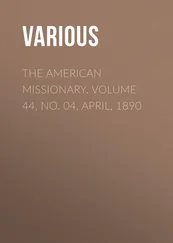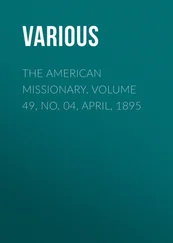Various - Appletons' Popular Science Monthly, April 1899
Здесь есть возможность читать онлайн «Various - Appletons' Popular Science Monthly, April 1899» — ознакомительный отрывок электронной книги совершенно бесплатно, а после прочтения отрывка купить полную версию. В некоторых случаях можно слушать аудио, скачать через торрент в формате fb2 и присутствует краткое содержание. Издательство: Иностранный паблик, Жанр: periodic, foreign_edu, на английском языке. Описание произведения, (предисловие) а так же отзывы посетителей доступны на портале библиотеки ЛибКат.
- Название:Appletons' Popular Science Monthly, April 1899
- Автор:
- Издательство:Иностранный паблик
- Жанр:
- Год:неизвестен
- ISBN:нет данных
- Рейтинг книги:5 / 5. Голосов: 1
-
Избранное:Добавить в избранное
- Отзывы:
-
Ваша оценка:
- 100
- 1
- 2
- 3
- 4
- 5
Appletons' Popular Science Monthly, April 1899: краткое содержание, описание и аннотация
Предлагаем к чтению аннотацию, описание, краткое содержание или предисловие (зависит от того, что написал сам автор книги «Appletons' Popular Science Monthly, April 1899»). Если вы не нашли необходимую информацию о книге — напишите в комментариях, мы постараемся отыскать её.
Appletons' Popular Science Monthly, April 1899 — читать онлайн ознакомительный отрывок
Ниже представлен текст книги, разбитый по страницам. Система сохранения места последней прочитанной страницы, позволяет с удобством читать онлайн бесплатно книгу «Appletons' Popular Science Monthly, April 1899», без необходимости каждый раз заново искать на чём Вы остановились. Поставьте закладку, и сможете в любой момент перейти на страницу, на которой закончили чтение.
Интервал:
Закладка:
Various
Appletons' Popular Science Monthly, April 1899 Volume LIV, No. 6, April 1899
THE STUFF THAT DREAMS ARE MADE OF
In our dreams we are taken back into an earlier world. It is a world much more like that of the savage, the child, the criminal, the madman, than is the world of our respectable civilized waking life. That is, in large part, it must be confessed, the charm of dreams. It is also the reason of their scientific value. Through our dreams we may realize our relation to stages of evolution we have long left behind, and by the self-vivisection of our sleeping life we may learn to know something regarding the mind of primitive man and the source of some of his beliefs, thus throwing light on the facts we obtain by ethnographic research.
This aspect of dreams has not always been kept steadily in sight, though it can no longer be said that the study of dreams is neglected. From one point of view or another – not only by the religious sect which, it appears, constitutes a "Dream Church" in Denmark, but by such carefully inquisitive investigators as those who have been trained under the inspiring influence of Prof. Stanley Hall – dreaming is seriously studied. I need not, therefore, apologize for the fact that I have during many years taken note from time to time and recorded the details and circumstances of vivid dreams when I could study their mechanism immediately on awakening, and that I have occupied myself, not with the singularities and marvels of dreaming – of which, indeed, I know little or nothing – but with their simplest and most general laws and tendencies. A few of these laws and tendencies I wish to set forth and illustrate. The interest of such a task is twofold. It not only reveals to us an archaic world of vast emotions and imperfect thoughts, but by helping us to attain a clear knowledge of the ordinary dream processes, it enables us in advance to deal with many of the extraordinary phenomena of dreaming, sometimes presented to us by wonder-loving people as awesomely mysterious, if not indeed supernatural. The careful analysis of mere ordinary dreams frequently gives us the key to these abnormal dreams.
Perhaps the chief and most frequent tendency in the mechanism of dreaming is that by which isolated impressions from waking life flow together in dreams to be welded into a whole. There is then produced, in the strictest sense, a confusion. For instance, a lady, who in the course of the day has admired a fine baby and bought a big fish for dinner, dreams with horror and surprise of finding a fully developed baby in a large codfish. The confusion may be more remote, embodying abstract ideas and without reference to recent impressions. Thus I dreamed that my wife was expounding to me a theory by which the substitution of slates for tiles in roofing had been accompanied by, and intimately associated with, the growing diminution of crime in England. Amid my wife's rather contemptuous opposition, I opposed this theory, pointing out the picturesqueness of tiles, their cheapness, greater comfort both in winter and summer, but at the same time it occurred to me as a peculiar coincidence that tiles should have a sanguinary tinge suggestive of criminal bloodthirstiness. I need scarcely say that this bizarre theory had never suggested itself to my waking thoughts. There was, however, a real connecting link in the confusion – the redness – and it is a noteworthy point, of great significance in the interpretation of dreams, that that link, although clearly active from the first, remained subconscious until the end of the dream, when it presented itself as an entirely novel coincidence.
The best simile for the mechanism of the most usual type of dream phenomena is the magic lantern. Our dreams are like dissolving views in which the dissolving process is carried on swiftly or slowly, but always uninterruptedly, so that, at any moment, two (often indeed more) incongruous pictures are presented to consciousness which strives to make one whole of them, and sometimes succeeds and is sometimes baffled. Or we may say that the problem presented to dreaming consciousness resembles that experiment in which psychologists pronounce three wholly unconnected words, and require the subject to combine them at once in a connected sentence. It is unnecessary to add that such analogies fail to indicate the subtle complexity of the apparatus which is at work in the manufacture of dreams.
It is the presence of the strife I have just referred to between apparently irreconcilable groups of images, in the effort of overcoming the critical skepticism of sleeping consciousness – a feeble skepticism, it may be, but, as many people do not seem to recognize, a real skepticism – that the impressive emotional effects of dreams are often displayed. It sometimes happens that two irreconcilable groups of impressions reach sleeping consciousness, one flowing from a recent stratum of memories, the other from an older stratum. A typical form of this phenomenon often occurs in our dreams of dead friends. Professor Sully remarks that in dreams of the dead "awareness of the fact of death wholly disappears, or reduces itself to a vague feeling of something delightfully wonderful in the restored presence." That, however, as I have elsewhere shown, 1 1 On Dreaming of the Dead. Psychological Review, September, 1895. In this paper I reported several cases showing the nature and evolution of dreams concerning dead friends. I have since received evidence from various friends and correspondents, scientific and unscientific, of both sexes, confirming my belief in a frequency of this type of dream. Professor Binet (L'Année Psychologique, 1896) has also furnished a case in support of my view, and is seeking for further evidence.
is not the typical process in dreaming of the dead; although in the later dreams of those who often see their dead friends during sleep, the process is abbreviated, and the friend's presence is accepted without a struggle – a very interesting point, for it tends to show that in dreams, as in the hypnotic state, the recollection of previous similar states of consciousness persists, and the illusion is strengthened by repetition.
In typical dreams of a dead friend there is a struggle between that stream of recent memories which represents him as dead and that older stream which represents him as living. These two streams are inevitably caused by the fact of death, which sets up a barrier between them and renders one set of memories incongruous with the other set. In dreams we are not able to arrange our memories chronologically, but we are perpetually reasoning and striving to be logical. Consequently the two conflicting streams of memories break against each other in restless conflict, and sleeping consciousness endeavors to propound some theory which will reconcile them. The most frequent theories are, as I have found, either that the news of the friend's death was altogether false, or that he had been buried alive by mistake, or else that having really died his soul has returned to earth for a brief space. The mental and emotional conflict which such dreams involve renders them very vivid. They make a profound impression even after awakening, and for some sensitive persons are too sacred to speak of. Even so cautious and skeptical a thinker as Renan, when, after the death of his beloved sister Henriette, he dreamed more than once that she had been buried alive, and that he heard her voice calling to him from her grave, had to still his horrible suspicions by the consideration that she had been tended by experienced doctors. On less well-balanced minds, and more especially in primitive stages of civilization, we can scarcely doubt that such dreams, resting as they do on the foundation of consciousness, have had a powerful influence in persuading man that death is but a transient fact, and that the soul is independent of the body. I do not wish to assert that they suffice to originate the belief. 2 2 In Japan stories of the returning of the dead are very common. Lafcadio Hearn gives one as told by a Japanese which closely resembles the type of dream I am discussing. "A lover resolves to commit suicide on the grave of his sweetheart. He found her tomb and knelt before it and prayed and wept, and whispered to her that which he was about to do. And suddenly he heard her voice cry to him 'Anata!' and felt her hand upon his hand; and he turned and saw her kneeling beside him, smiling and beautiful as he remembered her, only a little pale. Then his heart leaped so that he could not speak for the wonder and the doubt and the joy of that moment. But she said: 'Do not doubt; it is really I. I am not dead. It was all a mistake. I was buried because my parents thought me dead – buried too soon. Yet you see I am not dead, not a ghost. It is I; do not doubt it!'"
Интервал:
Закладка:
Похожие книги на «Appletons' Popular Science Monthly, April 1899»
Представляем Вашему вниманию похожие книги на «Appletons' Popular Science Monthly, April 1899» списком для выбора. Мы отобрали схожую по названию и смыслу литературу в надежде предоставить читателям больше вариантов отыскать новые, интересные, ещё непрочитанные произведения.
Обсуждение, отзывы о книге «Appletons' Popular Science Monthly, April 1899» и просто собственные мнения читателей. Оставьте ваши комментарии, напишите, что Вы думаете о произведении, его смысле или главных героях. Укажите что конкретно понравилось, а что нет, и почему Вы так считаете.












